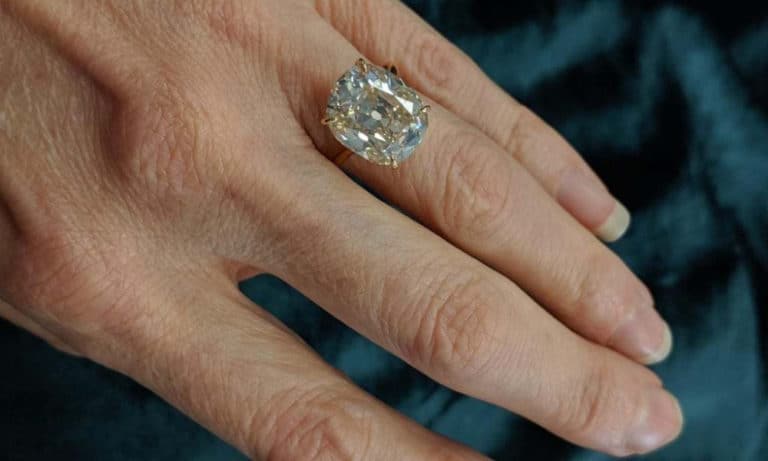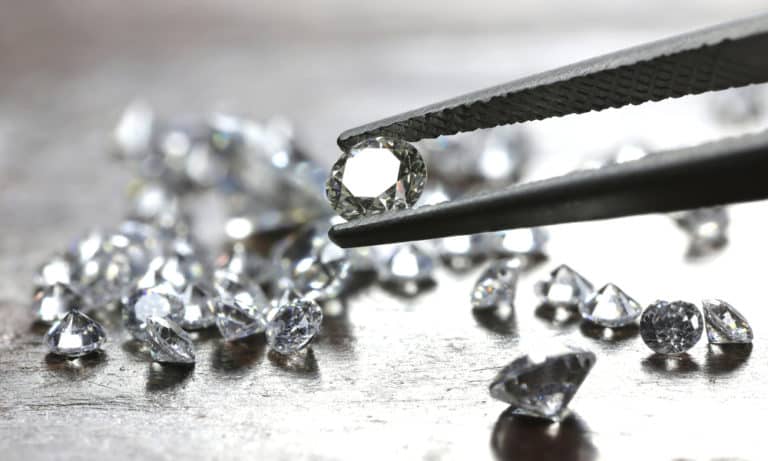
Are you looking for a unique diamond cut for your engagement ring or jewelry? A baguette diamond might be an excellent choice. Baguettes are believed to have emerged in the 16th century, but they only became popular in the 20th century. Not only do these diamonds have a long and rich history, but they are also stunners and will accentuate the beauty of any solitaire-style center-piece diamond.
In this guide, we will do a deep dive into the defining qualities of a baguette diamond. We’ll also include some tips to keep in mind if you are considering buying this diamond cut. So, without further ado, let us find out ‘what is a baguette diamond?’
What Is A Baguette Diamond?

A baguette diamond is a small, step-cut, elongated, and rectangle-shaped diamond. There are many variations, but most baguettes are cut in length to width ratio of 5:1, resulting in a perfect rectangle. Let us take a look at the main defining characteristics of a baguette diamond:
Edges
Unlike other step-cut stones such as Asscher and emerald that have cropped edges, the edges of a baguette diamond can be straight or tapered. A big difference between these step-cut stones is the corners—the corners of a baguette diamond are perfectly square, while those of an emerald are diagonally shaped.
Facets
Baguettes are quite small diamonds and only feature a maximum of 24 facets. A typical piece of polished diamond has 57 to 58 facets. The rectangular or sometimes square facets, which graduate from the diamonds’ table like terraces, give the baguette a charming effect. Due to the few facets, baguettes are best used as shoulder stones to accentuate the center stone in a wedding or engagement ring.
Scintillation
Because of its few facets, a baguette does not reflect and deflect light as brightly as other cuts such as brilliant round, princess, or even fellow step-cut diamonds such as emerald do. This is not necessarily a bad quality; the subdued nature of a baguette diamond ensures that the center diamond on a piece of jewelry shines.
History of Baguette Diamonds

A common misconception is that baguette rings are named after the French bread, but this couldn’t be further from the truth. Of course, the word has French origins; the term translates to rod or stick, but it is also derived from the word ‘bague,’ an old phrase that translates to ‘small jewel’ or ‘small ring.’
In the context of jewelry, the baguette is a predecessor of the hogback cut diamond, which was prominent in the mid-16th century. The renowned jewelry houses Cartier and Harry Winston re-popularized the baguette cut diamond in 1912. It became the leading style in the Art Deco era when geometrical shapes and clean lines were highly sought after in any piece of jewelry.
Pros And Cons Of Baguette Diamonds

Now that you know what a baguette diamond is let us look at some of the pros and cons of choosing this diamond cut.
Some perks of choosing baguette diamonds are:
-
Easy to place in various settings
Baguettes can be arranged in many different ways on a piece of jewelry, depending on your preferred style. Whether aligned horizontally, vertically, or in a pattern, baguette diamonds are versatile enough to get the job done.
-
Perfect side stones
Baguette stones don’t have the intense flame or brilliance found in popular stones such as the brilliant round cut. As such, these little geometrical diamonds are the ideal choice for side stones on an engagement or wedding ring. With their subdued nature, the baguettes play a supporting role while allowing the center diamond to get all the attention it deserves.
-
Pocket-friendly
Even though baguette cut diamonds have some excellent qualities, they are quite underrated and don’t receive as much attention as other step-cut stones such as the emerald cut. This is a blessing in disguise because baguettes are some of the most affordable diamonds on the market. That doesn’t mean that these diamonds are of a lower value; in fact, most high-end jewelry shops carry baguette diamonds.
Baguette cut diamonds have some solid advantages. But, before making your purchasing decision, there are a few downsides to keep in mind.
-
Less sparkle
If you are looking for a diamond with intense light and fire, baguette cut diamonds are not the best choice. These step-cut stones have few facets, which limits the amount of light the diamond can reflect. As such, these tiny diamonds do not have as much sparkle as other popular diamond cuts.
-
Easily shows inclusions
A diamond’s ability to hide inclusions/flaws is a desirable quality. However, baguettes do not do a very good job of hiding flaws, scratches, and dings. As such, it is best to choose a baguette with a clarity grade above VS2.
-
Unsuited for solitaires
Solitaires are jewelry that features a single middle diamond usually held by a set of prongs or a thin metal band. Despite having attractive angles and geometrical lines, baguette diamonds don’t make for great solitaires; they are best suited as supporting diamonds.
-
Hard to find
There is no doubt that baguettes have amazing qualities and are easy on the eye. Yet, this diamond cut is not as popular as one would expect it to be. Because the demand for this diamond style is comparably low, not too many jewelers stock it, making baguette diamonds quite hard to find.
Popular Baguette Diamond Settings
Baguette diamonds are best used as side stones to complement the main center stone. Other times, a series of diamonds grouped in a channel setting can make for a charming engagement or wedding ring.
Let us take a quick look at some popular baguette diamond ring settings. You can also check out this video to learn more about baguette diamonds and settings.
Three-stone
This is by far the most common setting. Here, two baguette diamonds are set side by side to highlight the charm of the round-cut diamond in the middle.
Channel set
In this setting, the baguettes are positioned all around the ring’s circumference, with the middle diamond being the point of reference. The channel set is a simple yet sophisticated look.
Ballerina
The ballerina setting is bold, fancy, and suitable for any jewelry lover who isn’t afraid to try something out of the ordinary. In a Ballerina diamond ring, the baguettes face outward, creating an attention-grabbing skirt pattern.
What To Look For When Buying Baguette Diamonds

As you can see, a baguette diamond has its unique characteristics, which are accentuated in various settings. Before buying your diamonds, there are a few factors you need to consider to make an informed purchasing decision.
Color and clarity
Baguette diamonds are not good at hiding color differences and flaws. Any variation in the diamonds that are set in a piece of jewelry will be noticeable. Ensure that all the baguettes you select are of the same color grade to avoid unsightly color variations, which can lower the aesthetics and value of the jewelry.
Keep in mind the color of the center piece. This piece and the baguette diamonds should have the same or near-same colors. For example, brilliant round cuts have an intense white glow about them. If you are looking to set baguette diamonds next to a brilliant round cut, there will be a significant color difference. To avoid these noticeable differences, opt for a baguette within the same color range as the brilliant round cut.
Inclusions
Inclusions are the flaws, abrasions, dings, and small cuts in a diamond resulting from the cutting and polishing process. These flaws can greatly interfere with a diamond’s clarity, and in turn, lower its value.
Some diamonds are better than others at hiding these flaws. Baguettes do not conceal inclusions; the flaws on the diamond will be visible even to the naked eye. The diamond has just a few facets, and any small inclusion is therefore noticeable. The solution here is to buy baguettes of a higher clarity to avoid value-lowering inclusions.
Symmetry
Step-cut facets are prone to imperfections which can compromise the appearance and inherent value of the diamond. Ensure that all 24 facets of the baguette you are eyeing are symmetrical with no visible deviations.
Buy in sets
As mentioned, ensure that the baguette diamonds you select are of a similar color, clarity, and symmetry. No two diamonds look exactly alike, but you should strive for similarity, especially if the baguettes will be used as supporting side stones. Buying the diamonds in sets of two can help prevent buying dissimilar diamonds.
Are Baguette Diamonds Worth It?
Baguette diamonds may not have the fire and light of a brilliant round cut or the popularity of an emerald. But, they make for beautiful accent stones that highlight the center stone on any piece of jewelry.
If you are keen on making an engagement or wedding band look slightly voluminous, setting baguette stones around the main stone can achieve this goal without breaking the bank.
Overall, baguette diamonds give you value for money and are the perfect definition of little diamonds that make a big difference.






